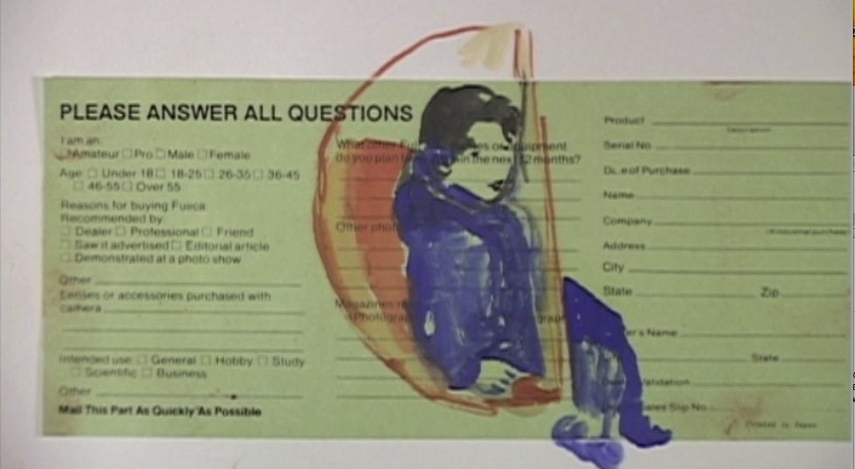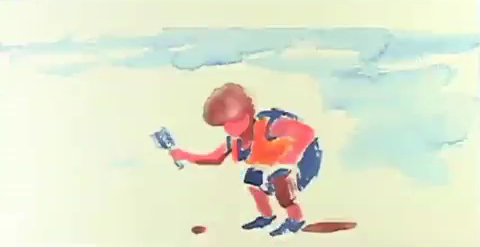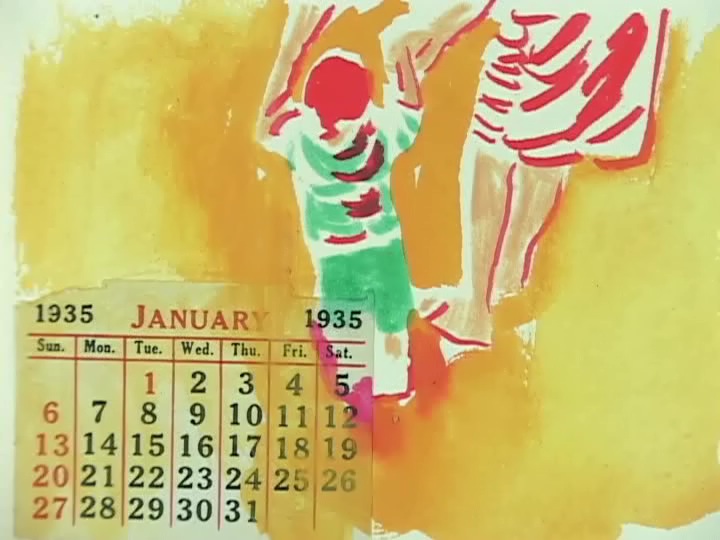Rolling Amnesia and the Omnivorous Now: Jeff Scher’s You Won’t Remember This Trilogy (2007–2011)
Lilly Husbands
“As I watch her growing up, spinning like a top around me, I realize that her childhood is not something I can grasp but rather—like the wind—something I feel tenderly brush against my cheek.” Lynne Sachs (Photograph, n. pag.)
Many philosophers who belong to what Paul Ricœur has called the empiricist “tradition of inwardness” (96) such as John Locke, David Hume, and William James, have noted that memory plays a vital role in what constitutes our sense of ourselves in both the long and the short term. It constitutes what makes up our personal histories as well as our ability to perceive and think from moment to moment (James 154). From the subjectivist films of Stan Brakhage to Jonas Mekas’s diary films, avant-garde cinema has had an enduring commitment to creating innovative and exploratory depictions of selfhood and personal memory. There has been a tendency particularly in American avant-garde cinema towards what Scott MacDonald calls the “self-revelatory” (6), making up what P. Adams Sitney refers to as the “subjective tradition” (7). Moving-image works that focus on issues of selfhood and memory are always in one way or another grappling with the irretrievability of the past, and however artists choose to represent and to interact with their own memories, their works are inevitably infused with a blend of desire and loss. Referring to Mekas’s diary films, Michael Renov writes of “the irreparable breach between experience and its externalized representation”, stating that “we are all of us lost in the chasm between our desire to recapture the past and the impossibility of a pristine return” (77). This impossibility of recapturing the past is perhaps nowhere made more evident than in our efforts to recall what it was like to be a very young child.
It is perhaps not surprising, then, that certain personal modes of experimental cinema should at times explore aspects of selfhood and memory through the filming of the filmmaker’s children.[1] As Marjorie Keller notes, “childhood is a particularly central theme in a tradition where artists have used the film medium to reflect on their own uniqueness” (The Untutored Eye 14–15). For filmmakers like Brakhage and Mekas, for instance, filming their children (and, often, those of their friends) was a natural part of the kind of personal filmmaking they practised. Whether using their children as metaphorical conduits for primary perception, as in Brakhage’s investigations of “the untutored eye” (12) in films like Scenes from Under Childhood (1967–1970), or documenting their children in order to reflect on the ephemeral nature of childhood, as in Mekas’s Paradise Not Yet Lost (a/k/a Oona’s Third Year) (1980), these kinds of films investigate aspects of selfhood, memory and the experience of time in relation to the unique period of a person’s life that is childhood. Part of what makes this period such a fascinating and conceptually rich subject for filmmakers and spectators alike lies in the fact that children’s capacity for remembering themselves and their experiences significantly diminishes as they grow older, and eventually these early years are almost entirely forgotten. This phenomenon is referred to in developmental and cognitive psychology as childhood or infantile amnesia (Howe and Courage, 305), and it has presented problems for the philosophy of memory since Locke first investigated the roles of memory and consciousness in the constitution of the identity of the self. These child-focused films ultimately reveal that there are certain aspects of childhood that remain forever inaccessible to adults. They inevitably approach their subjects to some extent from perspectives of exclusion—an exclusion that is shared by every adult spectator, including the child-as-adult who watches themselves onscreen at a later date.
There are few examples of these child-focused experimental works that use animation as their primary means of visual expression.[2] However, this article explores the ways in which New York–based experimental filmmaker and animator Jeff Scher’s animated You Won’t Remember This trilogy—consisting of You Won’t Remember This (2007), You Won’t Remember This Either (2009), and You Might Remember This (2011)—offers a unique contribution to this particular form of personal cinema. The three You Won’t Remember This animations invite spectators to reflect on the mnemonic imbalance that is specific to this particular temporal situation—where the parent is able to remember what the child will ultimately forget—in both a distilled and heightened way. The works align spectators with Scher’s perspective as a parent as well as with the children looking back amnestically on the events depicted. The “you” in each of the titles is instrumental in orientating spectators towards this reading of the works, as they address both Scher’s sons Buster and Oscar and the spectators of the works, effectively conflating the mnemonic status of the unwitnessed and the forgotten. The temporality of each work in the trilogy is complex, interwoven, and layered, as it engages with three distinct yet interconnected perspectives: that of Scher himself as witness to the depicted events (mediated first through the camera and then the animation process), that of the boys who do not remember themselves, and, finally, that of the spectator. This article aims to demonstrate how the formal and stylistic aspects of the animation technique that Scher employs in the You Won’t Remember This trilogy not only endow them with a special capacity to emphasise the universal nature of childhood amnesia, but also are paradoxically what make them resemble the act of remembering itself. It argues that Scher’s animations demonstrate that past experiences enter the present in the form of memory that is always also a living phenomenon, susceptible to the vicissitudes of mood, thought, and imagination.
Scher has been making experimental collage and animated films since he was trained in the experimental cinema programme at Bard College in the 1970s, where he studied under filmmakers such as Warren Sonbert, Adolfas Mekas, and Ernie Gehr. Steve Fore has suggested that some of Scher’s early films, such as Reasons to be Glad (1980), Milk of Amnesia (1992) and Garden of Regrets (1994), in which he rotoscopes a mixture of found and original footage, “visually evoke 1960s movements such as pop art and structuralist cinema” (113). However, he also points out that Scher’s films often thematically explore the relationship between memory and moving images (124) and that the brief but strikingly evocative activities depicted in the scene fragments that make up Scher’s films may be productively connected to Victor Burgin’s concept of the “sequence-image”, which Burgin defines as a very brief memory that has nevertheless made a lasting, if enigmatic impression on a person’s mind (16). In fact, throughout his career Scher has created works that are in dialogue with personal cinema and in particular with the diary tradition with its “documentation of dailiness, … personal meditation on one’s position in life, and … fragmentary style” (Keller, “The Apron” 94). In his more recent series of animated films called The Animated Life (2007–present), which has had the singular good fortune of being commissioned by and regularly featured on The New York Times’ Opinionator blog, Scher concentrates on moments from everyday life that quite often go unremarked. A part of The Animated Life series, the You Won’t Remember This trilogy’s short, evocative vignettes depict fleeting everyday moments in the early childhoods of his two sons Buster and Oscar that are situated somewhere between remembering and forgetting, and between the mundane and the extraordinary.
Scher’s unorthodox use of the rotoscope animation technique is one of the trilogy’s most distinguishing features. For each of the works, Scher traces images frame by frame from 16mm or digital live-action footage onto a variety of different paper surfaces, rendering each frame differently by using a range of materials such as watercolour, gouache, pastel, ink marker and charcoal to produce stylistically diverse images. In addition, some of the individual rotoscoped images are occasionally painted onto old receipts, bits of newspaper, mini calendars, tickets, luggage tags, labels, etc., creating painted collages that flash almost imperceptibly onscreen.
Figure 1: Momentary collage in You Might Remember This (Jeff Scher, 2011). opinionator.blogs.nytimes.com. Screenshot.
His rotoscoped paintings and drawings largely focus on the human figures in a scene, and within a given sequence the level of detail varies significantly, with some scenes depicting faces and places with relative thoroughness and others presenting their subjects as sparsely sketched figures against a white background.
Figure 2: Abstracted space in You Won’t Remember This Either (Jeff Scher, 2009). opinionator.blogs.nytimes.com. Screenshot.
However, Scher adheres enough to the movements and actions of the human figures in the original live-action footage so that the images’ wild fluctuations in colour and style nevertheless compose fluid animated sequences. Fore has described this quality of Scher’s animations as “a visual paradox”, stating that they present spectators with “a series of brief but entirely linear, uninterrupted motions that are simultaneously aggressively fragmented” (119). The rotoscope technique has traditionally been used to render the shapes and movements of animated figures with a high degree of realism (Bouldin 14), and although Scher’s works are protean and polychromatic, the rotoscope effect serves to imbue them with the weight of reality, as representations of real moments in his children’s lives. While Scher’s rotoscoping of these home-movie images on one level roots the figures in an indexical relation to a specific profilmic temporal and spatial reality, the technique also extracts them from their particular settings, opening the images up to being encountered in a more personalised manner, calling on spectators’ own memories and imaginations to fill in the details. In this sense, rotoscope in the You Won’t Remember This trilogy can be connected to a perceptual phenomenon that Scott McCloud describes as the “universality of cartoon imagery” (31). It refers to an effect that arises when the mind perceives the simplified face of a line-drawn cartoon character. He argues that “the more cartoony a face is, for instance, the more people it could be said to describe” (31). Although Oscar and Buster are not presented as cartoons in the works, Scher’s animation technique renders the boys’ features less specific than they would be in a live-action film, enabling the children to be interpreted at once as Scher’s sons and also potentially as many different children, thereby emphasising the universality of this remarkable mnemonic phenomenon.
The two-and-a-half-minute You Won’t Remember This, subtitled simply “Portrait of a Boy”, begins with a shot of a woman’s hand slowly stroking her pregnant stomach (recalling a similar image in Stan Brakhage’s Window Water Baby Moving (1959)), accompanied by Sam Bisbee’s soothing, lullaby-like piano playing on the soundtrack. The work proceeds to show Scher’s son Buster as he undergoes his earliest stages of growth. Spectators watch as the newborn sleeps, and we are shown a brief sequence of a woman’s fast approaching nipple, seen from the child’s point of view. Several scenes concentrate on the infant’s face in close-up, as if searching for a glimmer of recognition in the infant’s unfocused gaze. Many of these opening images of the child are rendered in different coloured outlines on plain white backgrounds, conveying an impression of the infant’s limited world. The slowly paced music and the soft outlines and watercolour paints that Scher uses in the film contrast with the characteristic “boiling” effect of rotoscope, which, as Lisa Cartwright notes, refers to “the look of a rotoscoped figure that seems to vibrate, breaking erratically out of the typical live-action form’s steady containing outline” (56). The effect accentuates the jitteriness of the child’s uncontrolled movements. Later sequences show the boy as he begins to look into the camera and smile. He sits up and, in the penultimate scene of the animation, begins to toddle with the help of his mother, whose solicitousness is distilled into a sketch of her legs, skirt, and hands as they hold the boy’s arms. You Won’t Remember This ends with the boy sitting and holding a book, looking at the camera, finally fully engaging with his father, and us. The slow, tinkling piano music heard on the soundtrack throughout the animation is expressive of tenderness and sleepiness, as if to intermingle the child’s and the parent’s perspectives together.
Figure 3: Buster toddling in You Won’t Remember This (Jeff Scher, 2007).
opinionator.blogs.nytimes.com. Screenshot.
The second film, the one-and-a-half-minute You Won’t Remember This Either, also subtitled a “Portrait of a Boy”, is accompanied by Shay Lynch’s upbeat music and has a comic feel as spectators witness the kaleidoscopic figure of Scher’s second son Oscar’s efforts to explore the world through locomotion. The animation begins with the varicoloured images of a young boy in a hooded jacket walking heavily towards a potted plant in the distance. He is seen walking from behind, surrounded by empty, white space, with only the pot flashing intermittently onscreen. Once he arrives at his destination, a fuller depiction reveals the boy as he picks something out of the pot and clumsily throws it to the ground. As the scene changes to images of the boy pushing a stroller, a cheerful accordion riff joins the piano’s jubilant melody, infusing the subsequent scenes with a sense of exuberance. You Won’t Remember This Either is more brightly coloured than the first animation of the trilogy, exhibiting a palette of blacks, deep blues, reds, yellows, oranges and greens. Its images are frequently painted on fragments of lettered paper in ways that are reminiscent of Cubist collage. Painting and drawing on ticket stubs, food wrappers, musical scores, pages from books adds a choppier, more textured rhythm to the flow of the rotoscoped sequences that harmonises with Oscar’s busy movements. In this way, the animation is literally composed from the detritus of his family’s everyday life. As the work progresses Oscar begins to move about more freely and quickly, the animation offers more detailed depictions of the spaces in which he moves. This fuller sense of place is also a noticeable feature of the two-and-a-half-minute You Might Remember This, which shows Buster between the ages of six and ten. Its visual richness is suggestive of the boy’s more expansive sense of the world around him. Also set to one of Lynch’s upbeat scores, Buster is shown doing various energetic activities, frequently clothed in a sports jersey, indicating his interest in athletics. This energy is visually manifested in the blurring of the rotoscoped lines in some of the earlier sequences, drawn with crayons and pastels. Like You Won’t Remember This Either, the rotoscoped sequences in this work are both more colourful and frequently interspersed with collaged images. Scher’s renderings of Buster and the environment around him often appear abstract and cartoonish, creating a contrastive dynamic with the otherwise more fully detailed presentation of the imagery. In this work, Buster is much more aware of and engaged with the camera, first playing hide-and-seek behind a telephone pole on a sidewalk and then looking towards his father as he balances on the back of a park bench. Towards the end of the animation, we watch from the sidelines, like dutiful parents, as he bats and runs to first base during a little league baseball game. The last sequence of the animation shows Buster in a New York Yankees baseball cap, jersey and sunglasses as he looks straight ahead; the multi-coloured background begins to swirl behind him like a pinwheel, ending abruptly when Buster walks out of the frame.
The swirling background in the final sequence of You Might Remember This encapsulates what can be seen as the driving force behind the trilogy as a whole, as it visualises the vortex of time’s passage and the ephemerality of these childhood moments. In the notes accompanying the film on Scher’s A Year in The Animated Life DVD, Scher has commented:
The film came from the notion that Buster wouldn’t remember these years, as, indeed, he doesn’t seem to, but the more I drew the more I realized that I didn’t remember them as clearly as I thought I would, either. There is something about the omnivorous now in parenting, and the constantly shifting challenges and demands of the moment, that creates a kind of rolling amnesia for everything yesterday. This film is an attempt to hold onto some of those moments and also to share them with Buster. (You Won’t Remember This, n. pag.)
As this quotation reveals, the animations are the products of a father/artist’s desire to achieve the impossible by remembering for his children (and, by extension, for the audience as well) the early days of their childhoods. For Buster and Oscar, the moments Scher captures in the You Won’t Remember This trilogy are irretrievable due to the enigmatic phenomenon of childhood amnesia. According to psychologists Mark L. Howe and Mary L. Courage, childhood amnesia refers to adults’ inability to recall memories from before the first two to five years of their lives. Childhood amnesia also refers to adults’ limited access to memories from up to the age of ten. It spans the period in childhood before the full development of what is known as “autobiographical memory”, which Howe and Courage define as “memory for information and events pertaining to the self” (306). This universal phenomenon prohibits direct access to the subjective experiences of early childhood, rendering our understanding of this period of a person’s life largely speculative. As I have mentioned, interest in childhood amnesia’s effect on the way we understand our senses of self reaches back to the introspective philosophies of memory that arose during the Enlightenment, when philosophers such as Locke and Hume took an interest in the relationship between childhood, memory and personal identity. The difficulty these philosophers faced was that of reconciling an understanding of selfhood based upon the continuity of memory and consciousness with the phenomenon of childhood amnesia. Locke’s empirical psychology considered conscious memory as the source of personal identity. Locke writes: “as far as this consciousness can be extended backwards to any past action or thought, so far reaches the identity of that person: it is the same self now it was then; and ‘tis by the same self with this present one that now reflects on it, that the action was done” (138; emphasis in original). According to this way of thinking, the inability to remember one’s early childhood creates an unbridgeable separation between the two states of being in one’s life. The You Won’t Remember This trilogy can be seen as an attempt to capture evanescent moments in the early development of a human being before he becomes a person, in the Lockean sense that links personal identity to conscious memory (Locke 143). The unique formal and visual style of these experimental animations goes beyond the basic urge to record moments for posterity to reflect the paradox at the root of this endeavour, which is essentially to remind someone of something they have experienced but cannot remember.
Every adult who has seen him or herself as a young child in photos or home movies has felt on some level the uncanny sensation that the young child in those pictures is alien to his or her adult sense of self. The image of the child fails to resonate with what William James referred to as a sense of “the spiritual me” (48). James describes this quality of the empirical self as “the entire collection of my states of consciousness, my psychic faculties and dispositions taken concretely” (48). It is comprised of “the more active-feeling states of consciousness” (48; emphasis in original). More than just the normal misalignment of perspective that occurs while watching oneself on film (one does not remember oneself from the exterior, as the camera records, etc.), one’s memory is not stimulated by a recognition of the time and place depicted, and one does not experience the “warmth and intimacy” (68) that James affirms would normally accompany personal memories. As Gareth Matthews notes, “the reason for this sense of alienation from the child pictured there is the Lockean reason that one simply cannot remember doing or experiencing the things that child is pictured doing or experiencing. One simply cannot remember being that child” (83). Indeed, for the boys, the trilogy’s images (and the footage they are drawn from) will ultimately take the place of actual memories, becoming what Roland Barthes calls an effect of “counter-memory” caused by the photograph, which actually blocks memory and replaces it (91). As abstracted, animated characters, the boys are in a sense even more alien to themselves than they would be in live-action film, and yet Scher’s animation process offers them the unusual experience of glimpsing their father’s feelings and memories as they are expressed in his artistic interpretations.
Not only does Scher’s You Won’t Remember This trilogy explicitly present spectators with references to the phenomenon of childhood amnesia on a thematic level, strongly suggested by the works’ titles, on a formal level it also opens itself up to being read as an investigation of the role of self-sameness in identity during these early stages of a person’s life, when he or she is physically and mentally developing at a rate that is much faster than that of the rest of his or her life. The extraordinariness of this phenomenon is perhaps nowhere more perceptible than in the watchful gaze of the parent of a young child. Not only are new parents daily confronted with the mysterious workings of early childhood, they also experience the strangeness of watching their child grow and change at an accelerated pace. Each of the You Won’t Remember This animations acts as an abbreviation of this developmental process. We see Buster transform from a helpless infant into a responsive little boy over the course of You Won’t Remember This, and in You Won’t Remember This Either we watch Oscar grow and slowly gain control over his body. In You Might Remember This, Buster’s personality, physicality and interests are on full display. In a personal communication, Scher observed that “the mysteries of early childhood are re-experienced in parenthood. They are laid bare on a day to day basis from an adult perspective” (“Question”). Regarding You Won’t Remember This Either, he maintains that “what continues to amaze me about parenting is how it simultaneously expands and condenses time … One day you notice that he isn’t the same guy he was two weeks ago, he’s someone older and new, but he still wants you to unwrap his cheese stick” (“You Won’t Remember This Either”). What Fore referred to as the visual paradox of Scher’s animation technique—its fragmented yet uninterrupted movements—can be read as a metaphor for this childhood condition of being simultaneously both the same and different over time (“someone older and new”).
The particular aesthetic features of Scher’s rotoscoping technique have made the You Won’t Remember This trilogy resemble the kind of filtering process that is natural to the mind’s retention and reconstitution of visual memories. In being selective about which portions of an image to depict, Scher is effectively graphically representing the necessary process of what James calls “foreshortening”, or “the omission of an enormous number of the facts which filled [recollected times]” (167), which ironically enables the mind to remember at all. The tracings of the rotoscope technique resemble mnemonic traces, like Plato’s metaphor in the Theaetetus of the slab of wax upon which memories are imprinted (qtd. in Ricœur 9). As Fore notes, through the short vignettes that he links together, “Scher is in a sense simulating the ways in which unconscious processes of condensation and displacement intersect with the production of memory in the human mind” (125). Scher’s fragments resemble those mysterious image-sequences that stand out against the vast backdrop of the experiences and events of waking life that are forever lost from memory. The You Won’t Remember This trilogy can be productively connected to phenomenologist Edward S. Casey’s description of the three aspects of “mnemonic presentation” that characterise the act of remembering: the “specific content”, the “memory-frame”, and the “aura” (66). The specific content, which is the object of the memory, remains throughout the trilogy determinately concentrated on the boys—their faces, their bodies, their actions. Casey defines the memory-frame as “a setting by which the specific content of a memory may be situated” (68). This aspect of the works’ “worldhood” is manifested in the various “scene[s] and surroundings” (69) that situate the boys in their environments. The sparseness of many of the settings depicted in the trilogy is actually in harmony with Casey’s observation that “we do not always apprehend the memory-frame with the same perspicuity. Sometimes it is only dimly manifest, and often it is not thematized” (68). Finally, Casey’s notion of the aura is described as the “atmosphere” (78; emphasis in original) that suffuses the memory. He writes:
Unlike the margin, which encircles the specific content and the memory-frame, the atmosphere is experienced as pervading the presentation itself. Where the former rings around what we remember, the latter is given as a presence felt throughout. … The atmosphere pervading the mnemonic presentation and ourselves as rememberers is characterised by a particular emotion or group of emotions, lending to this atmosphere its dominant tonality. (78; emphasis in original)
In the You Won’t Remember This trilogy, the music and the colourful images set the emotional tone. The aura that pervades the works is at points joyous, tender, humorous, and bittersweet. In the second two works of the trilogy especially, the jaunty, almost giddy tones and melodies of Shay Lynch’s original musical compositions conjoin with the energetic vibrancy of Scher’s colours (his palette and use of water-based paints endows each individual painting with a particularly luminous intensity) to simultaneously convey a sense of the children’s enjoyment of their playtime activities and a feeling of affectionate and lighthearted fatherliness.
It is obvious that the animations in the trilogy serve a twofold function for Scher: to capture and depict otherwise lost and forgotten moments in his children’s childhoods for their future viewing but also to produce a record, for him, of his time as a parent of young children. The notes that Scher wrote to accompany You Might Remember This on the Opinionator state that “all three films are about memory, which I like to think of as single grains of sand culled from the steady flow in the hourglass of our life and turned to pearls, to be strung and locked away where they wait, slowly fading” (“You Might Remember This”). These are surely the most common impulses behind conventional home-movie making; however, for Scher, the animation process itself plays an important role in firmly establishing these moments in his memory. As Cartwright has pointed out, rotoscoping is an intensely time-consuming and labour-intensive practice. She notes that “the act of tracing by hand must be repeated thousands of times to render a significant length of film, making repetition and the compulsion to get the outline right critical matters of the trade” (51). Scher remarked that “the process of painting multiple sequential images lets you investigate the moments in a deep way” (“Question”). Writing about the latest animation, You Might Remember This, he observed, “Buster might actually remember some of the moments depicted in this film; some he might remember because of this film. I will remember them all, having now engraved them in memory with crayon, paint and pencil” (“Question”). The amount of time Scher spends tracing and compiling the individual frames that make up a given sequence vastly exceeds its recorded duration, and the painstaking process allows him to immerse himself in these fleeting moments. But these moments recorded by his camera are not exactly his memories. Scher acknowledges as much when he notes that “the more I drew the more I realized that I didn’t remember [these moments] as clearly as I thought I would” (“Question”). However, beyond ingraining these cherished and ephemeral moments in his memory, rotoscoping allows him to reconsider and respond to the live-action imagery in ways that investigate a variety of painterly and emotional expressions. Unlike the live-action footage from which his films are drawn, Scher’s animated paintings themselves are able to act as expressions of memory, emotion, and forgetting.
Notes
[1] Other examples of this practice are found in Ken Jacobs’s Nissan Ariana Window (1969), Gunvor Grundel Nelson’s My Name is Oona (1969), Stephen Gebhardt’s Growth Cycle: A Numbers Racket (1969) and Headache (1969), James Broughton’s This Is It (1971), Gordon Ball’s Clouds of Glory (1981), Frank Beisendorfer’s Hot Dog Party (2001), Lynne Sachs’s Photograph of Wind (2001), Leonard Lipton’s Life on Earth (1972), and Guy Sherwin’s Messages (1983) and Prelude (1996).
[2] To my knowledge, there are few other child-focused experimental animated films. Al Jarnow’s Jesse: The First Year (1979) is a time-lapse film made from still photographs of Jarnow’s son Jesse taken everyday for his first year. John and Faith Hubley’s Cockaboody (1973) also focuses on their two children, although in a less formally experimental style.
References
1. Ball, Gordon, dir. Clouds of Glory. 1981. Film.
2. Barthes, Roland. Camera Lucida: Reflections on Photography. Trans. Richard Howard. London: Vintage, 2000. Print.
3. Beisendorfer, Frank, dir. Hot Dog Party. 2001. Film.
4. Bisbee, Sam. “You Won’t Remember This.” 2007. Musical Score.
5. Bouldin, Joanna. “Cadaver of the Real: Animation, Rotoscoping and the Politics of the Body.” Animation Journal 12 (2004): 7–31. Print.
6. Brakhage, Stan. “Metaphors on Vision.” Essential Brakhage: Selected Writings on Filmmaking by Stan Brakhage. Ed. Bruce R. McPherson. Kingston: McPherson & Company, 2001. 12–13. Print.
7 ---, dir. Scenes from Under Childhood. 1967–1970. Film.
8. ---, dir. Window Water Baby Moving. 1959. Film.
9. Broughton, James, dir. This Is It. 1971. Film.
10. Burgin, Victor. The Remembered Film. London: Reaktion Books, 2004. Print.
11. Cartwright, Lisa. “The Hands of the Animator: Rotoscopic Projection, Condensation, and Repetition Automatism in the Fleischer Apparatus.” Body & Society 18.1 (2012): 47–78. Print.
12. Casey, Edward S. Remembering: A Phenomenological Study. Second edition. Bloomington: Indiana U.P., 2000. Print.
13. Fore, Steve. “Romancing the Rotoscope: Self-Reflexivity and the Reality-Effect in the Animations of Jeff Scher.” Animation: An Interdisciplinary Journal 2.2 (2007): 111–27. Print.
14. Gebhardt, Stephen, dir. Growth Cycle: A Numbers Racket. 1969. Film.
15. ---, dir. Headache. 1969. Film.
16. Howe, Mark L., and Mary L. Courage. “On Resolving the Enigma of Infantile Amnesia.” Psychological Bulletin. 113.2 (1993): 305–26. Print.
17. Hubley, John, and Faith Hubley, dir. Cockaboody. 1973. Film.
18. Jacobs, Ken, dir. Nissan Ariana Window. 1969. Film.
19. James, William. Psychology: The Briefer Course. New York: Dover Publications, Inc., 2001. Print.
20. Jarnow, Al, dir. Jesse: The First Year. 1979. Film.
21. Keller, Marjorie. “The Apron Strings of Jonas Mekas.” To Free the Cinema: Jonas Mekas and the New York Underground. Ed. David E. James. Princeton: Princeton U.P., 1992. 83–96. Print.
22. ---. The Untutored Eye: Childhood in the films of Cocteau, Cornell, and Brakhage. London: Associated U.P., 1986. Print.23. Lipton, Leonard, dir. Life on Earth. 1972. Film.
24. Locke, John. An Essay Concerning Human Understanding (1689). Ed. Kenneth P. Winkler. Cambridge: Hackett Publishing Company, 1996. Print.
25. Lynch, Shay. “You Won’t Remember This Either.” 2009. Musical score.
26. ---. “You Might Remember This.” 2011. Musical score.
27. MacDonald, Scott. Avant-Garde Film: Motion Studies. Cambridge: Cambridge U.P., 1993. Print.
28. Matthews, Gareth B. The Philosophy of Childhood. Cambridge: Harvard U.P., 1994. Print.
29. McCloud, Scott. Understanding Comics: The Invisible Art. New York: Harper Collins Publishers, 1993. Print.
30. Mekas, Jonas. Paradise Not Yet Lost. Film-Makers’ Cooperative On-line Catalogue. Web. May 2011. <http://www.film-makerscoop.com/search/search.php>.
31. ---, dir. Paradise Not Yet Lost (a/k/a Oona’s Third Year). 1980. Film.
32. Nelson, Gunvor Grundel, dir. My Name is Oona. 1969. Film.
33. Renov, Michael. The Subject of Documentary. Minneapolis: U. of Minnesota P., 2004. Print.
34. Ricœur, Paul. Memory, History, Forgetting. Trans. Kathleen Blamey and David Pellauer. Chicago: U. of Chicago P., 2004. Print.
35. Sachs, Lynne. Photograph of Wind. DVD liner notes. N. pag. 10 Short Films by Lynne Sachs. Microcinema International, 2008. DVD, print.
36. ---, dir. Photograph of Wind. 2001. Film.
37. Scher, Jeff, dir. The Animated Life. 2007–present. Film.
38. ---, dir. Garden of Regrets. 1994. Film.
39. ---, dir. Milk of Amnesia. 1992. Film.
40. ---, dir. Reasons to be Glad. 1980. Film.
41. ---. “Re: Question about your work.” Message to Lilly Husbands. 20 May 2013. Email.
42. ---, dir. You Might Remember This. 2011. Film.
43. ---. “You Might Remember This.” Opinionator. 18 June 2011. Web. June 2013. <http://opinionator.blogs.nytimes.com/2011/06/18/you-might-remember-this/>.
44. ---, dir. You Won’t Remember This. 2007. Film.
45. ---. “You Won’t Remember This.” Opinionator. 23 Aug 2007. Web. April 2014. <http://opinionator.blogs.nytimes.com/2007/08/23/you-wont-remember-this/>.
46. ---. You Won’t Remember This. DVD liner notes. N. pag. A Year in The Animated Life, 2008. DVD, print.
47. ---, dir. You Won’t Remember This Either. 2009. Film.
48. ---. “You Won’t Remember This Either.” Opinionator. 1 June 2009. Web. April 2014. <http://opinionator.blogs.nytimes.com/2009/01/06/you-wont-remember-this-either/#more-12267>.
49. Sherwin, Guy, dir. Messages. 1983. Film.
50. ---, dir. Prelude. 1996. Film.
51. Sitney, P. Adams. “Introduction.” Film Culture Reader. New York: Cooper Square Press, 2000. 3–12. Print.
Suggested Citation
Husbands, L. (2014) 'Rolling amnesia and the omnivorous now: Jeff Scher's You Won't Remember This trilogy (2007–2011)', Alphaville: Journal of Film and Screen Media, 8, pp. 76–88. https://doi.org/10.33178/alpha.8.05.
Lilly Husbands recently received her doctorate degree in Film Studies from King’s College London. Her research is concerned with closely investigating contemporary North American and British works of experimental animation, focusing particularly on the varieties of non-normative aesthetic experience that such works invite and cultivate. Her broader research interests include experimental cinema and video, animation and special effects, film aesthetics, film philosophy, spectatorship, and film music. She is the author of “The Meta-Physics of Data: Philosophical Science in Semiconductor’s Animated Videos”, Moving Image Review & Art Journal (MIRAJ) 2:2.












